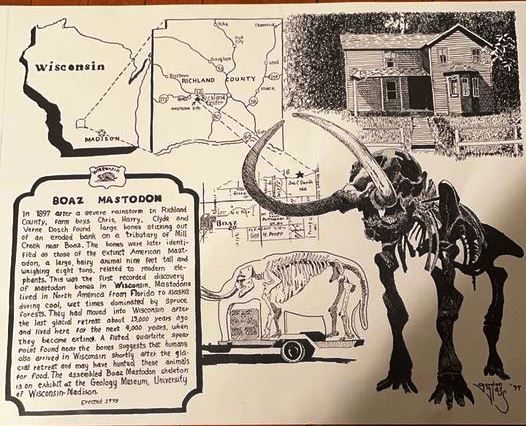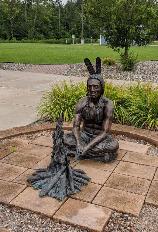
Gays Mills Wisconsin- In the Heart of the Kickapoo Valley
In Remembrance of those now passed and the stories they left behind. May they and
their stories never be forgotten.
Mary L. Coleman Sutherland
HOME PAGE
In Remembrance of those now passed and the stories they left behind. May they and
their stories never be forgotten.
Mary L. Coleman Sutherland
HOME PAGE
| Purchase your e-magazine featuring The Kickapoo Valley at burlingtonnews.net/Legends.html |
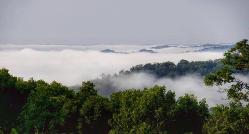
This may look like the Smokey Mountains but Crawford and Richland County has mountains of their own known as the
'Ocooch Mountain Range'. If you have ever been in this area, you will quickly recognize it as 'God's Country'. Courtesy of
Historical and Architectural Tours of Richland Center
'Ocooch Mountain Range'. If you have ever been in this area, you will quickly recognize it as 'God's Country'. Courtesy of
Historical and Architectural Tours of Richland Center

| Brought to you by Legends Magazine - In Search of Legend and Lore . Every Town Has it's own Story Dedicated to James and Dorothy Coleman - Gays Mills Residents Another Sutherland Production burlingtonnews.net/Legends.html |



| Contact Us Legends Magazine 248 Carver Street - Winslow Illinois 61089 bsutherland@wi.rr.com 608 214 6800 or 815 367 1006 HOME PAGE |
Gays Mills Nestled in the Midst of the Ocooch Mountain Range

Kickapoo River Valley is one of the oldest river
systems in the world.
At 125 miles, the Kickapoo River is the longest
tributary of the Wisconsin River, meandering from its
source in Wilton to Wauzeka, where it joins the
Wisconsin. The proverbial crow flying between these
two towns would only cover 65 miles. But Kickapoo is
an Algonquin word meaning “one who goes there,
then here,” an accurate description of a river that
manages to flow north, south, east and west for
some portion of its 125 mile length. Because the
glaciers that missed the Driftless Area did not
change its natural course, the Kickapoo River Valley
is one of the oldest river systems in the world.
Rising some 350 feet above the river are the Ocooch
Mountains, named for a small band of Indians called
the Ocoche who once made these hills home. The
“mountains” are really a region of forested hills, lush
valleys and sandstone cliffs
systems in the world.
At 125 miles, the Kickapoo River is the longest
tributary of the Wisconsin River, meandering from its
source in Wilton to Wauzeka, where it joins the
Wisconsin. The proverbial crow flying between these
two towns would only cover 65 miles. But Kickapoo is
an Algonquin word meaning “one who goes there,
then here,” an accurate description of a river that
manages to flow north, south, east and west for
some portion of its 125 mile length. Because the
glaciers that missed the Driftless Area did not
change its natural course, the Kickapoo River Valley
is one of the oldest river systems in the world.
Rising some 350 feet above the river are the Ocooch
Mountains, named for a small band of Indians called
the Ocoche who once made these hills home. The
“mountains” are really a region of forested hills, lush
valleys and sandstone cliffs
Ancient People and Native AmerIndians of the Kickapoo Valley
Sacred Sites and Discovered Artifacts
For more information purchase our Kickapoo Valley Issue
Sacred Sites and Discovered Artifacts
For more information purchase our Kickapoo Valley Issue
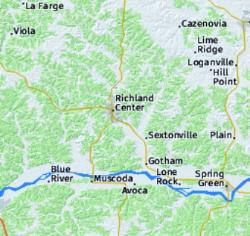
Rock Lake
Rock Lake 2
Rock Lake 4 Canary
Island
Rock Lake 5
Rock Lake Native
American Lore
Rock Lake Pyramids
Skulls and Mysteries
Lake Monsters of Rock
Lake
Aztalan
Gays Mills
Franks Hill
Burlington
Michigan
Kentucky
Cannabalism
Toltec
Artifacts
Rock Lake 2
Rock Lake 4 Canary
Island
Rock Lake 5
Rock Lake Native
American Lore
Rock Lake Pyramids
Skulls and Mysteries
Lake Monsters of Rock
Lake
Aztalan
Gays Mills
Franks Hill
Burlington
Michigan
Kentucky
Cannabalism
Toltec
Artifacts
The Pottawatomie Traditions
Indians of Wisconsin area
Story by Gary Mitchell sent to Mary Sutherland
Many of the places in Wisconsin are named after the Native American Indians living in the area at the
time. Wisconsin was the meeting place of two of the greatest ethnological divisions of the Native
American Indian east of the Rocky Mountains. These divisions were the Lakota (Sioux) the Algonquin ,
thus the Indian names of towns and places i.e. Chippewa, Winnebago, Menominee, Potawatomie and
Sauk.
Long before the Europeans arrived on the shores of this continent, Pottawatomie villages were
scattered all over the beautiful Great Lakes area and were, in many respects, totally autonomous of
each other. The word tribe was not a household word then. Most of these villages were relatively small
in number and were culturally bound together by strong individual and community support principles.
For instance, decision making was facilitated by considering the opinions of all the people in the village.
Among the Pottawatomie villages, and other Indian villages as well, the principle of independence of the
people was absolute, and they recognized no authority of anyone to impose limits on that way of life.
Some might fit the role of a leader, or a "Chief," when it came to hunting and military expeditions, but
even then the other village members went on a voluntary basis.
Wise village elders fearing the loss of all their family in these hunting/military expeditions, sent out only
one son in each party. This logical group decision by the village elders did minimize losses.
This is how the concept of assigning a color to family members developed. The firstborn was given the
color blue and the next red and each subsequent family member had alternating color. From that point
on, each son proudly wore their colors in battle, and of course, families could rest easier.
The leaders of each village might secure obedience by persuasion but this didn't always work either. If a
village member broke a solemn promise of peace with other tribal groups, or later with the whites, there
was little a leader could do about it. His only recourse was to offer presents to the offended party to
restore the peace.
No one enjoyed a supreme power over the rest of the village. In truth, most leadership positions were
attained by personal prestige and the charisma of the individual.
To become a chief, the warriors had to show traits of generosity and other leadership capabilities. They
often dressed very poorly because they had given away much of their possessions in order to be liked
by the rest of the village. They carried strings of beads around their necks and would give them away as
presents so as to get the right to speak at various gatherings.
Most leaders earned the title of chief the hard way and that was usually by war time achievements. And
most villages did rally around one person in time of war and this was how some Pottawatomie were
able to make a name for themselves.
Men such as Wabaunsee (Nah-Ke-ses), Shabbona, Black Pheasant (Mka-da-puk-ke), Half- Day,
Spotka, Mad Sturgeon and Big Foot moved forward to grab that coveted title. All played important roles in
the defense of their homelands and hunting grounds, both with other tribes and later with the whites.
In one story, Shabbona achieved many battlefield accomplishments fighting along side the great
Shawnee war chief, Tecumseh. For this, he was singled out by the elderly Chief Spotka: "I have always
been a warrior and in my youth I won great honors and excelled beyond those with whom I lived and for
this I was finally made a chief. At that time, I said when a warrior rose among us who was as I was then,
to him I would give over my title. Shabbona is such a one ---not only as I was then, but even more. From
this day forward, he is your chief." Shabbona, at nineteen summers, became the youngest chief of any
Pottawatomie village. A rare feat since most chiefs were much older.
Wabaunsee, the younger brother of Black Partridge, was in the same vein. He won acclaim and fear
from many for his battlefield exploits. On one war expedition, he captured 40 Osage prisoners
single-handedly. He was respected and feared by the surrounding tribes because of his bravery.
Wabaunsee's name meant the dawn of the day, or the causer of paleness. He was to say 'When I kill
the enemy he turns pale, resembling the first light of the day.'
Oldest evidence of man found in Wisconsin - Cut marks on Mammoths
Indians of Wisconsin area
Story by Gary Mitchell sent to Mary Sutherland
Many of the places in Wisconsin are named after the Native American Indians living in the area at the
time. Wisconsin was the meeting place of two of the greatest ethnological divisions of the Native
American Indian east of the Rocky Mountains. These divisions were the Lakota (Sioux) the Algonquin ,
thus the Indian names of towns and places i.e. Chippewa, Winnebago, Menominee, Potawatomie and
Sauk.
Long before the Europeans arrived on the shores of this continent, Pottawatomie villages were
scattered all over the beautiful Great Lakes area and were, in many respects, totally autonomous of
each other. The word tribe was not a household word then. Most of these villages were relatively small
in number and were culturally bound together by strong individual and community support principles.
For instance, decision making was facilitated by considering the opinions of all the people in the village.
Among the Pottawatomie villages, and other Indian villages as well, the principle of independence of the
people was absolute, and they recognized no authority of anyone to impose limits on that way of life.
Some might fit the role of a leader, or a "Chief," when it came to hunting and military expeditions, but
even then the other village members went on a voluntary basis.
Wise village elders fearing the loss of all their family in these hunting/military expeditions, sent out only
one son in each party. This logical group decision by the village elders did minimize losses.
This is how the concept of assigning a color to family members developed. The firstborn was given the
color blue and the next red and each subsequent family member had alternating color. From that point
on, each son proudly wore their colors in battle, and of course, families could rest easier.
The leaders of each village might secure obedience by persuasion but this didn't always work either. If a
village member broke a solemn promise of peace with other tribal groups, or later with the whites, there
was little a leader could do about it. His only recourse was to offer presents to the offended party to
restore the peace.
No one enjoyed a supreme power over the rest of the village. In truth, most leadership positions were
attained by personal prestige and the charisma of the individual.
To become a chief, the warriors had to show traits of generosity and other leadership capabilities. They
often dressed very poorly because they had given away much of their possessions in order to be liked
by the rest of the village. They carried strings of beads around their necks and would give them away as
presents so as to get the right to speak at various gatherings.
Most leaders earned the title of chief the hard way and that was usually by war time achievements. And
most villages did rally around one person in time of war and this was how some Pottawatomie were
able to make a name for themselves.
Men such as Wabaunsee (Nah-Ke-ses), Shabbona, Black Pheasant (Mka-da-puk-ke), Half- Day,
Spotka, Mad Sturgeon and Big Foot moved forward to grab that coveted title. All played important roles in
the defense of their homelands and hunting grounds, both with other tribes and later with the whites.
In one story, Shabbona achieved many battlefield accomplishments fighting along side the great
Shawnee war chief, Tecumseh. For this, he was singled out by the elderly Chief Spotka: "I have always
been a warrior and in my youth I won great honors and excelled beyond those with whom I lived and for
this I was finally made a chief. At that time, I said when a warrior rose among us who was as I was then,
to him I would give over my title. Shabbona is such a one ---not only as I was then, but even more. From
this day forward, he is your chief." Shabbona, at nineteen summers, became the youngest chief of any
Pottawatomie village. A rare feat since most chiefs were much older.
Wabaunsee, the younger brother of Black Partridge, was in the same vein. He won acclaim and fear
from many for his battlefield exploits. On one war expedition, he captured 40 Osage prisoners
single-handedly. He was respected and feared by the surrounding tribes because of his bravery.
Wabaunsee's name meant the dawn of the day, or the causer of paleness. He was to say 'When I kill
the enemy he turns pale, resembling the first light of the day.'
Oldest evidence of man found in Wisconsin - Cut marks on Mammoths
Imperial Rome in Crawford County, Wisconsin –
Frank Joseph , The Lost Colonies of Ancient
America
Ceramic lamp was unearthed in 1969, in Crawford County, Freeman
Township, on a hillside field overlooking the Mississippi River. A
farmers plow got hung up on a root and when the plow was cleared, the
lamp was found face down in the furrow.
Lamp is 5 inches long, 3.5 inches across, and 1.25 inches thick
Its front , judging by its central hole for the flame, depicts what appears
to be the body of a woman between two pairs of other human figures,
sitting and engaged in conversation.
The back features a central circle – its outer rim studded with 19 knobs
– enclosing eight lines. This eight-line symbol recurs six times in the
circle around the fire hole, again just beneath it, an once more at the foot
of the lamp, bringing its total repetition on the front to eight.
To either side of the circle on the back is the representation of a man
chasing a four-legged animal, In one version, he bears a knife in his
right hand, while the animal looks forward. In the other, the animal looks
back at him. Although the object’s deliberate symbolism may be
elusive, Roman astrologers identifed the number eight with Venus, both
the planet and the goddess, who may be the female figure portrayed in
the oil lamp.
If the 19 knobs coming around the perimeter of the back side circle – a
common sign for the sun- represent years, then the reference here is to
a solar eclipse, because ‘eclipses of the sun tend to recur in periods of
nineteen years.’
Removing it entirely from any native American Indian context, the female
figure is shown with long, wavy hair , falling down her back; wearing a
diadem with cloth attachment, the most common feminine headdress of
the Greco-Roman World.
Frank Joseph , The Lost Colonies of Ancient
America
Ceramic lamp was unearthed in 1969, in Crawford County, Freeman
Township, on a hillside field overlooking the Mississippi River. A
farmers plow got hung up on a root and when the plow was cleared, the
lamp was found face down in the furrow.
Lamp is 5 inches long, 3.5 inches across, and 1.25 inches thick
Its front , judging by its central hole for the flame, depicts what appears
to be the body of a woman between two pairs of other human figures,
sitting and engaged in conversation.
The back features a central circle – its outer rim studded with 19 knobs
– enclosing eight lines. This eight-line symbol recurs six times in the
circle around the fire hole, again just beneath it, an once more at the foot
of the lamp, bringing its total repetition on the front to eight.
To either side of the circle on the back is the representation of a man
chasing a four-legged animal, In one version, he bears a knife in his
right hand, while the animal looks forward. In the other, the animal looks
back at him. Although the object’s deliberate symbolism may be
elusive, Roman astrologers identifed the number eight with Venus, both
the planet and the goddess, who may be the female figure portrayed in
the oil lamp.
If the 19 knobs coming around the perimeter of the back side circle – a
common sign for the sun- represent years, then the reference here is to
a solar eclipse, because ‘eclipses of the sun tend to recur in periods of
nineteen years.’
Removing it entirely from any native American Indian context, the female
figure is shown with long, wavy hair , falling down her back; wearing a
diadem with cloth attachment, the most common feminine headdress of
the Greco-Roman World.

Mysteries of the Caves along the Wisconsin River –
Boaz - Gotham – Muscoda – Aztalan
These mysteries surround the numerous caves of the region round about Gotham. Some of these caves have been found to be small, while others are found to be hundreds of feet
long with ceilings far above one's head. Some like Big Eagle cave are filled with beautiful crystalline deposits, containing stalactites and stalagmites in abundance. One need not go
to Kentucky to go caving.
At Gotham the Pine River flows down from the north and enters the Wisconsin River, babbling as it does so, of the curious natural rock bridge under which it flows well up into
Richland County. At one time, at the junction of these two rivers was a rather large village home to the Winnebago Indians. The beginning, according to the native population, dated
back to an unknown time.
According to one of their legends, in the far dim past of this tribe, so long ago that the exact time has long since been lost to memory, three adolescent Indian boys left their village to
hunt deer in the hills. After failing to return back to their village for two days and fearing that they may have been captured by hostile ‘Sac’ Indians, the chief of the tribe Tcaxcepxedega
(Great Eagle) sent a band of warriors to follow their trail. The trail led to the head of a deep ravine and ended at the mouth of a cave. Two or three of the braves made torches and
entered the black cavern, leaving the others outside, awaiting their return. With sun beginning to sink, the braves began calling down into the cave for their return. As the callers
strained to listen, they were perplexed and amazed to hear, very faintly, as though it came from the ends of the earth, the “Death Song of an Indian”. It was strangely beautiful, yet far
beyond anything they had ever heard before. Soon, however, the lure of the song grew into a feeling of uneasiness. Of the remaining eight of their band of warriors, six grasped their
weapons and ventured into the cave. They, too did not return.. The sun was all but gone in the west and to the straining ears of the waiting pair the only thing heard was the faint
Indian Song of Death.
With increased anxiety and fear, the remaining two hurried their way back to their village. The next day Great Eagle, led 100 braves to the cave. The main body stayed outside, while
30 warriors and five torch bearers cautiously slid into the great black hole. Soon thereafter their lights disappeared as did all sound from them. There was no answer back to those
calling for them outside the cave, except echoes of their own voices and the distinctive lull of the Indian Song of Death.
In desperation Great Eagle formed his men in a human chain, hand clutching hand. The first man led them courageously into the cavern. He had gone but a short distance when the
second man suddenly realized that his hand, which but a moment before had held that of the leader, was clutching nothing! Quickly he reached forward, but just as quickly the hand
of the third man was lost to the hand of the second. There had not been the sound of a fall or of any violence; in terror the human chain drew back out of the cave.
Great Eagle held a council. Perhaps what a hand could not hold a tout rope could, Great Eagle reasoned, as he tied the end of a stout rope most securely around the waist of a
volunteer. He was to jerk the rope as he proceeded in, and to be pulled out by the men on the outside as soon as his jerking ceased.
In he went. He had not gone far when his jerks on the rope ceased. As quickly as lightning the men hauled in the rope. But there came out of the cave only an empty loop, tied just as
it had been when put around the man. The man had vanished. There was not a mark on the rope.
A ghostly terror settled upon the people in the ravine, and in the stark silence of their fear they heard again the strains of the Song of Death. Great Eagle forbade anyone from going
near the cave, an edict which didn’t need any enforcement. Except for the foolhardy, few led by too curious a spirit who dared to investigate, never to return.
Now after many moons there came one day from out of the forest a man the like of whom had never been seen before. His skin was pale and soft, his hair white and silken, and a
great white beard reached to his waist. He was utterly blind and understood not the tongue of the Winnebago nor was he understood by them. He was led by an Indian boy of 10
summers, with a longing, faraway look in his eyes too old for his years. This Indian boy looked identically like one of those who had first gone into the cave even the mother claiming
him for her own, but the boy maintained he came from a tribe far to the northwest. This boy acted also as the old man's interpreter.
It was soon evident that the strange man with the long beard was a great healer with powers far beyond those of any medicine man of the tribe. In a comparatively short time,
because of his unusual skill, power and kindness, he was called The Great Healer; by the Winnebago and revered by everyone.
One day Great Eagle told the Great Healer, through the boy, his interpreter, of the cave of the Indian Song of Death.
Lead me to this cave, said the blind healer.
And Great Eagle led him to the ravine, with all the people following and forming a great semi-circle about the mouth of the cave. Not a sound disturbed the forest as all eyes watched
the Great Healer and his youthful guide walk slowly and deliberately down into the darkness.
Again there came the Song of Death, but louder now and closer it seemed, so that the leaves of the trees stirred to and fro to its rhythm. All the warriors in the assembly nervously
fingered their weapons. The footsteps of the two going into the cave finally died out and with a suddenness that filled the ravine with an alarming silence, the Song of Death stopped.
Then, faintly at first, but gradually louder, the sound of footsteps came from the cave, until, after an endless minute, the lone figure of the Great Healer issued from the cave. His eyes
were closed and a beautiful, calm and serene smile delicately touched his lips.
He stopped, lifted his face and arms towards the sun whose slanting evening rays filtered down through the leaves and in an unknown tongue he sang the Song of Death; while he
walked slowly and deliberately toward the river, with the people following him.
At the river's edge he stepped into a canoe, and without a paddle the canoe swung into the river and carried the Great Healer, to where no one knew, never to be seen again.
Several days later, a brave, bolder than his companions, ventured into the silent cave. To the amazement of his comrades who had tried to prevent his entrance, he came out again
saying that he had followed the cavern until it became so low that he would have been forced to crawl had he gone farther.
With another companion he again entered and this time the two crawled on hands and knees until they reached a gigantic room. After lighting a torch their light revealed the
skeletons of hundreds of Indians, lying face downward with arms outstretched toward a gigantic throne formed in the far wall. The great throne was empty.
In terror the two Indians returned to the outer light and told their story. Great Eagle and his council surmised that the cave was sacred to some great spirit and they decreed that the
cavern entrance be closed with dirt and rocks. After a few generations knowledge of its location perished among the Indians and after a few more generations even the story of the
cave was lost, saved by a certain few story loving warriors of the forest. Centuries later, in 1848, the town of Richland City, now no longer extant, was founded on the site of the
ancient Winnebago city. Then in 1891, by accident as it were,
a citizen of Milwaukee while reading the Courier, a newspaper of Vienna, Austria, came upon an article written by an Austrian scientist. [The following is that article.]
“One morning in the spring of 1887 I received in my mail a letter postmarked Richland City, Wis., U. S. A. It was from Paul Seifert, whom I had known at school. He wrote that he had
gone to America, landed in New York, drifted to northern Wisconsin, floated down the Wisconsin river on a raft and become acquainted with a German living at Richland City. He had
married this man's beautiful daughter, was living very happily and had four daughters. So we renewed our friendship by letter.”
“I asked Paul in one of my letters whether he could send me some relics of the American aborigines. In a very short time I received a package. It contained most magnificent relics of
American prehistoric times.”
“In 1891 I paid him a visit and finally the last day of my visit came. It was a beautiful moonlight night. I spoke to Paul about his promise to show me the place where he had found the
relics. He said, 'Will you promise to follow me where I lead?' My reply was, 'I shall be your shadow.'”
“... Darkness and damp air surrounded us. Paul lit another torch. I cannot describe the horror I felt. The bottom of the cave was covered with skeletons of a vanished race. Skulls
were everywhere. Here perished a tribe; very near I could say, a nation.
Their belongings were scattered among the bones; Battle axes of stone, ancient pottery, whole and in fragments, flint arrows and spears, whole and broken, everywhere.”
“'Here,' said Paul 'is the mine of the relics I have sent you.' Now I understand his remark, 'The chills ran down my back.' How true. Here on a shelf of stone I found a beautiful quartzite
spear beside the bones of a human hand.”
“So we went along the cave until we entered another passageway, beginning to hear a curious noise. As we went farther it sounded louder, more and more so, until it sounded like
the howling of a lot of maniacs and the moaning of the dying under torture. I asked Paul to tell me, for the love of heaven, what it was making that terrible noise. He said that it was
the falling waters and the rushing of the wind through the crevices above. All at once I saw a blue light flicker here and there. It came nearer and nearer. I could not stand it any
longer. 'Oh, how horrible, oh, Paul let us get out of here.'”
“So we retraced our steps through the cave of the dead, passed on back to the long rope, climbed up, passed through cave and passage, till we stood once more in the open air.
Conjecture if you will whether this be the cave of the legend. Seifert admitted to representatives of the state historical society that there was such a cave but he refused consistently to
tell its location, saying that 'No one will ever find the cave. I have planted grass and bushes to grow over its mouth.'”
“A neighbor of Seifert, hearing a loud blast on the bluff many years ago, climbed the hill and found Seifert blasting. On inquiry Seifert said 'There was a hole in the rocks here and I
was afraid boys might fall into it sometime, so I have closed it up.'
Dr. John Booher, Jr., Richland Center, and Tom Lewis, Watertown, hoping that this may have been the entrance to the mystery cave, sank a shaft on the spot in September, 1929, but
found no possible opening to a cave.”
In investigating the effigy mounds of Frank’s Hill near Muscoda which is not far from Gotham, I have heard the local legends of caves with buried treasures of the Ancient Ones. Many
have looked for this lost cave but none have found it. A lot of these caves have caches of valuables left untouched. Read the following article by Professor Bill and he will share even
more of these mystery caves and the transporting of treasures.
KEEPERS OF THE FLAME
From NATOW.org. Updated original post. Better source
.
The Potawatomi Tribe is considered one of the Woodland groups of Indians, belonging to the Algonquin linguistic family tree. The name Potawatomi means “people of the place of
the fire”. Their history is one of endurance, survival, and strong traditional values that still thrive today.
In the early centuries before Europeans, the Potawatomi lived north and east of Lakes Huron, Erie, and Ontario. They were once allied with the Odawa and Ojibwa tribes in a
confederation known as the Council of the Three Fires. The Potawatomi land base consisted of lower Michigan, northern Indiana, Ohio, Illinois and eastern Wisconsin.
They prospered through hunting, fishing, and gathering. Before the arrival of the first Europeans in the late 1500s and early 1600s, many Potawatomi had begun to move further
inland to the eastern shore of Lake Michigan. It was there that the first French fur traders and Jesuits began to write about these people known as “the people of the place of fire.”
The Potawatomi, (Bodwéwadmi) were given the task of keeping this sacred fire among the three, hence the name “Keepers of the Fire".
CONTINUED TO CRIMES ON THE MISSISSIPPI - FROM DESOTA TO NEW ORLEANS
Boaz - Gotham – Muscoda – Aztalan
These mysteries surround the numerous caves of the region round about Gotham. Some of these caves have been found to be small, while others are found to be hundreds of feet
long with ceilings far above one's head. Some like Big Eagle cave are filled with beautiful crystalline deposits, containing stalactites and stalagmites in abundance. One need not go
to Kentucky to go caving.
At Gotham the Pine River flows down from the north and enters the Wisconsin River, babbling as it does so, of the curious natural rock bridge under which it flows well up into
Richland County. At one time, at the junction of these two rivers was a rather large village home to the Winnebago Indians. The beginning, according to the native population, dated
back to an unknown time.
According to one of their legends, in the far dim past of this tribe, so long ago that the exact time has long since been lost to memory, three adolescent Indian boys left their village to
hunt deer in the hills. After failing to return back to their village for two days and fearing that they may have been captured by hostile ‘Sac’ Indians, the chief of the tribe Tcaxcepxedega
(Great Eagle) sent a band of warriors to follow their trail. The trail led to the head of a deep ravine and ended at the mouth of a cave. Two or three of the braves made torches and
entered the black cavern, leaving the others outside, awaiting their return. With sun beginning to sink, the braves began calling down into the cave for their return. As the callers
strained to listen, they were perplexed and amazed to hear, very faintly, as though it came from the ends of the earth, the “Death Song of an Indian”. It was strangely beautiful, yet far
beyond anything they had ever heard before. Soon, however, the lure of the song grew into a feeling of uneasiness. Of the remaining eight of their band of warriors, six grasped their
weapons and ventured into the cave. They, too did not return.. The sun was all but gone in the west and to the straining ears of the waiting pair the only thing heard was the faint
Indian Song of Death.
With increased anxiety and fear, the remaining two hurried their way back to their village. The next day Great Eagle, led 100 braves to the cave. The main body stayed outside, while
30 warriors and five torch bearers cautiously slid into the great black hole. Soon thereafter their lights disappeared as did all sound from them. There was no answer back to those
calling for them outside the cave, except echoes of their own voices and the distinctive lull of the Indian Song of Death.
In desperation Great Eagle formed his men in a human chain, hand clutching hand. The first man led them courageously into the cavern. He had gone but a short distance when the
second man suddenly realized that his hand, which but a moment before had held that of the leader, was clutching nothing! Quickly he reached forward, but just as quickly the hand
of the third man was lost to the hand of the second. There had not been the sound of a fall or of any violence; in terror the human chain drew back out of the cave.
Great Eagle held a council. Perhaps what a hand could not hold a tout rope could, Great Eagle reasoned, as he tied the end of a stout rope most securely around the waist of a
volunteer. He was to jerk the rope as he proceeded in, and to be pulled out by the men on the outside as soon as his jerking ceased.
In he went. He had not gone far when his jerks on the rope ceased. As quickly as lightning the men hauled in the rope. But there came out of the cave only an empty loop, tied just as
it had been when put around the man. The man had vanished. There was not a mark on the rope.
A ghostly terror settled upon the people in the ravine, and in the stark silence of their fear they heard again the strains of the Song of Death. Great Eagle forbade anyone from going
near the cave, an edict which didn’t need any enforcement. Except for the foolhardy, few led by too curious a spirit who dared to investigate, never to return.
Now after many moons there came one day from out of the forest a man the like of whom had never been seen before. His skin was pale and soft, his hair white and silken, and a
great white beard reached to his waist. He was utterly blind and understood not the tongue of the Winnebago nor was he understood by them. He was led by an Indian boy of 10
summers, with a longing, faraway look in his eyes too old for his years. This Indian boy looked identically like one of those who had first gone into the cave even the mother claiming
him for her own, but the boy maintained he came from a tribe far to the northwest. This boy acted also as the old man's interpreter.
It was soon evident that the strange man with the long beard was a great healer with powers far beyond those of any medicine man of the tribe. In a comparatively short time,
because of his unusual skill, power and kindness, he was called The Great Healer; by the Winnebago and revered by everyone.
One day Great Eagle told the Great Healer, through the boy, his interpreter, of the cave of the Indian Song of Death.
Lead me to this cave, said the blind healer.
And Great Eagle led him to the ravine, with all the people following and forming a great semi-circle about the mouth of the cave. Not a sound disturbed the forest as all eyes watched
the Great Healer and his youthful guide walk slowly and deliberately down into the darkness.
Again there came the Song of Death, but louder now and closer it seemed, so that the leaves of the trees stirred to and fro to its rhythm. All the warriors in the assembly nervously
fingered their weapons. The footsteps of the two going into the cave finally died out and with a suddenness that filled the ravine with an alarming silence, the Song of Death stopped.
Then, faintly at first, but gradually louder, the sound of footsteps came from the cave, until, after an endless minute, the lone figure of the Great Healer issued from the cave. His eyes
were closed and a beautiful, calm and serene smile delicately touched his lips.
He stopped, lifted his face and arms towards the sun whose slanting evening rays filtered down through the leaves and in an unknown tongue he sang the Song of Death; while he
walked slowly and deliberately toward the river, with the people following him.
At the river's edge he stepped into a canoe, and without a paddle the canoe swung into the river and carried the Great Healer, to where no one knew, never to be seen again.
Several days later, a brave, bolder than his companions, ventured into the silent cave. To the amazement of his comrades who had tried to prevent his entrance, he came out again
saying that he had followed the cavern until it became so low that he would have been forced to crawl had he gone farther.
With another companion he again entered and this time the two crawled on hands and knees until they reached a gigantic room. After lighting a torch their light revealed the
skeletons of hundreds of Indians, lying face downward with arms outstretched toward a gigantic throne formed in the far wall. The great throne was empty.
In terror the two Indians returned to the outer light and told their story. Great Eagle and his council surmised that the cave was sacred to some great spirit and they decreed that the
cavern entrance be closed with dirt and rocks. After a few generations knowledge of its location perished among the Indians and after a few more generations even the story of the
cave was lost, saved by a certain few story loving warriors of the forest. Centuries later, in 1848, the town of Richland City, now no longer extant, was founded on the site of the
ancient Winnebago city. Then in 1891, by accident as it were,
a citizen of Milwaukee while reading the Courier, a newspaper of Vienna, Austria, came upon an article written by an Austrian scientist. [The following is that article.]
“One morning in the spring of 1887 I received in my mail a letter postmarked Richland City, Wis., U. S. A. It was from Paul Seifert, whom I had known at school. He wrote that he had
gone to America, landed in New York, drifted to northern Wisconsin, floated down the Wisconsin river on a raft and become acquainted with a German living at Richland City. He had
married this man's beautiful daughter, was living very happily and had four daughters. So we renewed our friendship by letter.”
“I asked Paul in one of my letters whether he could send me some relics of the American aborigines. In a very short time I received a package. It contained most magnificent relics of
American prehistoric times.”
“In 1891 I paid him a visit and finally the last day of my visit came. It was a beautiful moonlight night. I spoke to Paul about his promise to show me the place where he had found the
relics. He said, 'Will you promise to follow me where I lead?' My reply was, 'I shall be your shadow.'”
“... Darkness and damp air surrounded us. Paul lit another torch. I cannot describe the horror I felt. The bottom of the cave was covered with skeletons of a vanished race. Skulls
were everywhere. Here perished a tribe; very near I could say, a nation.
Their belongings were scattered among the bones; Battle axes of stone, ancient pottery, whole and in fragments, flint arrows and spears, whole and broken, everywhere.”
“'Here,' said Paul 'is the mine of the relics I have sent you.' Now I understand his remark, 'The chills ran down my back.' How true. Here on a shelf of stone I found a beautiful quartzite
spear beside the bones of a human hand.”
“So we went along the cave until we entered another passageway, beginning to hear a curious noise. As we went farther it sounded louder, more and more so, until it sounded like
the howling of a lot of maniacs and the moaning of the dying under torture. I asked Paul to tell me, for the love of heaven, what it was making that terrible noise. He said that it was
the falling waters and the rushing of the wind through the crevices above. All at once I saw a blue light flicker here and there. It came nearer and nearer. I could not stand it any
longer. 'Oh, how horrible, oh, Paul let us get out of here.'”
“So we retraced our steps through the cave of the dead, passed on back to the long rope, climbed up, passed through cave and passage, till we stood once more in the open air.
Conjecture if you will whether this be the cave of the legend. Seifert admitted to representatives of the state historical society that there was such a cave but he refused consistently to
tell its location, saying that 'No one will ever find the cave. I have planted grass and bushes to grow over its mouth.'”
“A neighbor of Seifert, hearing a loud blast on the bluff many years ago, climbed the hill and found Seifert blasting. On inquiry Seifert said 'There was a hole in the rocks here and I
was afraid boys might fall into it sometime, so I have closed it up.'
Dr. John Booher, Jr., Richland Center, and Tom Lewis, Watertown, hoping that this may have been the entrance to the mystery cave, sank a shaft on the spot in September, 1929, but
found no possible opening to a cave.”
In investigating the effigy mounds of Frank’s Hill near Muscoda which is not far from Gotham, I have heard the local legends of caves with buried treasures of the Ancient Ones. Many
have looked for this lost cave but none have found it. A lot of these caves have caches of valuables left untouched. Read the following article by Professor Bill and he will share even
more of these mystery caves and the transporting of treasures.
KEEPERS OF THE FLAME
From NATOW.org. Updated original post. Better source
.
The Potawatomi Tribe is considered one of the Woodland groups of Indians, belonging to the Algonquin linguistic family tree. The name Potawatomi means “people of the place of
the fire”. Their history is one of endurance, survival, and strong traditional values that still thrive today.
In the early centuries before Europeans, the Potawatomi lived north and east of Lakes Huron, Erie, and Ontario. They were once allied with the Odawa and Ojibwa tribes in a
confederation known as the Council of the Three Fires. The Potawatomi land base consisted of lower Michigan, northern Indiana, Ohio, Illinois and eastern Wisconsin.
They prospered through hunting, fishing, and gathering. Before the arrival of the first Europeans in the late 1500s and early 1600s, many Potawatomi had begun to move further
inland to the eastern shore of Lake Michigan. It was there that the first French fur traders and Jesuits began to write about these people known as “the people of the place of fire.”
The Potawatomi, (Bodwéwadmi) were given the task of keeping this sacred fire among the three, hence the name “Keepers of the Fire".
CONTINUED TO CRIMES ON THE MISSISSIPPI - FROM DESOTA TO NEW ORLEANS
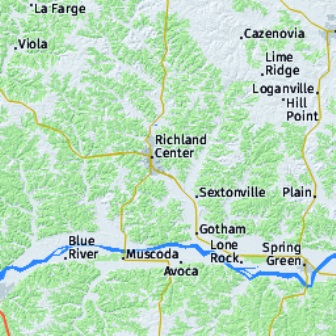
GIANT SKELETONS FOUND ALONG WITH ARTIFACTS IN ANCIENT BURIAL SITES
On the west bank of the Kickapoo River, at or near Gays Mills on Sec. 28, T. 10, n.R. 4, W. is a group of effigies (earthen mounds)
The figure of one animal in particular, has attracted more or less attention. It resembles a wolf, and is some 5 or 6 rods in length from the tip of the nose to the end of the tail. The
figure is well proportioned and symmetrical. Close to this is the figure of another animal, that is thought to be a bear and several other mounds in the group which have never been
examined closely.
Concerning the mounds in the south and central part of Crawford Country I would like to attention to a GIANT skeleton excavated at Lynxville. In the year of 1864 , parties were
engaged in excavating in the east bank of the Mississippi River, for the foundation of a warehouse. At a depth of 14 feet below the surface, the workmen came upon the skeleton of a
giant, in a tolerable good state of preservation, the skeleton was 8 feet 2 inches in length and measured 2 feet 2 inches across the pelvis or from the out edge of the hip joint to hip
joint. A quantity of bears, claws, and claws of some other animals apparently, worn as a necklace was found. They had holes drilled through them and had been strung. The bowl of a
pipe, finely polished and of fine workmanship, made of obsidian, was also found with the skeleton.
The pipe bowl was finely wrought into the figure of an animal, thought to be a lynx. There were two layers of human bones above him, the first some 4 feet below the surface, the next
layers some 8 feet from the surface. This shows that a very long period of time must have elapsed since the giant was interred. We have no reason to suppose that the giant was
buried at first 14 feet below the surface. It is reasonable to think, due to circumstances not mentioned in this article, that at least 1,000 years have rolled away since his burial.
At another point, about six miles below from where this skeleton was found, at the mouth of the Sioux Coulee, on Sec 18, T.8, N.R.6, W, one of the agents from the Smithsonian
Institute from Washington, exhumed the remains of another skeleton the size of which was calculated to be about 9 feet in length. Some copper implements were found with this, a
copper breast plate and hatchet were amongst them.
About 3 miles N.E. of where this first giant remains were discovered was the huge figure of a man lying on his back, the limbs, head and all were perfect in form. This figure was
about 8 rods in length, when discovered 30 years ago by me, but the farmer plow had nearly destroyed the last trace of it or nearly leveled it with the natural surface. I found near this
figure a bird ( a brant I judged by its size) partly sculptured out of a hard smooth rock, the breast and neck and a part of the head had been neatly polished and was finely
proportioned, and if the workman had finished his work in the style he had commenced no sculpture at the present day could have excelled it.
Source Pizarro Cook, published in the American Antiquarian and Oriental Journal, Volume 9
Copper tools have been found in Northern Wisconsin dating to 4,000 B.C. Some of these tools have been found in the area of Crow Hollow, located along the Kickapoo River in
Crawford County. From the dating, they were thought to have been made and used approximately 5,000 years ago.
On the west bank of the Kickapoo River, at or near Gays Mills on Sec. 28, T. 10, n.R. 4, W. is a group of effigies (earthen mounds)
The figure of one animal in particular, has attracted more or less attention. It resembles a wolf, and is some 5 or 6 rods in length from the tip of the nose to the end of the tail. The
figure is well proportioned and symmetrical. Close to this is the figure of another animal, that is thought to be a bear and several other mounds in the group which have never been
examined closely.
Concerning the mounds in the south and central part of Crawford Country I would like to attention to a GIANT skeleton excavated at Lynxville. In the year of 1864 , parties were
engaged in excavating in the east bank of the Mississippi River, for the foundation of a warehouse. At a depth of 14 feet below the surface, the workmen came upon the skeleton of a
giant, in a tolerable good state of preservation, the skeleton was 8 feet 2 inches in length and measured 2 feet 2 inches across the pelvis or from the out edge of the hip joint to hip
joint. A quantity of bears, claws, and claws of some other animals apparently, worn as a necklace was found. They had holes drilled through them and had been strung. The bowl of a
pipe, finely polished and of fine workmanship, made of obsidian, was also found with the skeleton.
The pipe bowl was finely wrought into the figure of an animal, thought to be a lynx. There were two layers of human bones above him, the first some 4 feet below the surface, the next
layers some 8 feet from the surface. This shows that a very long period of time must have elapsed since the giant was interred. We have no reason to suppose that the giant was
buried at first 14 feet below the surface. It is reasonable to think, due to circumstances not mentioned in this article, that at least 1,000 years have rolled away since his burial.
At another point, about six miles below from where this skeleton was found, at the mouth of the Sioux Coulee, on Sec 18, T.8, N.R.6, W, one of the agents from the Smithsonian
Institute from Washington, exhumed the remains of another skeleton the size of which was calculated to be about 9 feet in length. Some copper implements were found with this, a
copper breast plate and hatchet were amongst them.
About 3 miles N.E. of where this first giant remains were discovered was the huge figure of a man lying on his back, the limbs, head and all were perfect in form. This figure was
about 8 rods in length, when discovered 30 years ago by me, but the farmer plow had nearly destroyed the last trace of it or nearly leveled it with the natural surface. I found near this
figure a bird ( a brant I judged by its size) partly sculptured out of a hard smooth rock, the breast and neck and a part of the head had been neatly polished and was finely
proportioned, and if the workman had finished his work in the style he had commenced no sculpture at the present day could have excelled it.
Source Pizarro Cook, published in the American Antiquarian and Oriental Journal, Volume 9
Copper tools have been found in Northern Wisconsin dating to 4,000 B.C. Some of these tools have been found in the area of Crow Hollow, located along the Kickapoo River in
Crawford County. From the dating, they were thought to have been made and used approximately 5,000 years ago.
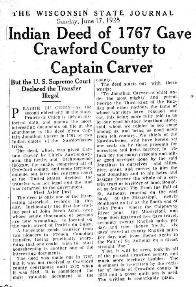
Indian Deed of 1767 gave Crawford County to Captain Carver...but the
U.S. Supreme Court declared the transfer illegal. Click here for a
larger view of article
U.S. Supreme Court declared the transfer illegal. Click here for a
larger view of article
